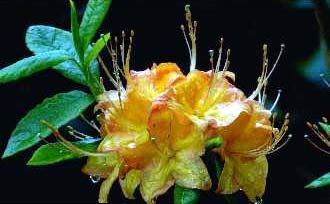In general, conifers protect themselves against disease through tannins in their sap. But pollution and inadequate care will impair their natural resistance and make them susceptible to otherwise harmless infections.
Coniferous trees and shrubs occupy a very special place in the garden. As magnificent specimens, they are attention-getters in their own right; in groups, they counterbalance the free and easy growth habits of deciduous trees and shrubs.
Not a few of the most beautiful and most valuable conifers demand careful maintenance. Those that have been introduced from exotic, far-off climes rarely find optimum conditions for healthy growth. Many become sickly; their needles discolor and drop prematurely, and foliage that once covered the trees densely often begins to look spotty.
Increase in Diseases
In most instances, the causes for disease can be found in improper location and inadequate care. But disease may also be caused by animal-inflicted damage or by viral and fungal infections. It is remarkable and saddening to note how the numbers of diseased coniferous trees and shrubs have reached alarming proportions in recent years. Forest trees that have been damaged and weakened already by industrially polluted air are succumbing in ever increasing numbers to fungi that had heretofore played only a secondary role in disease. So-called debilitating parasites, which under normal circumstances are harmless and only attack sick and dying trees, have been discovered in increasing numbers and have exacerbated the destructive effects of pollution.
Rust Fungi
Every now and then, fungal diseases develop in the home garden. Rust fungi are particularly widespread on juniper bushes. Frequently, their presence is not detected for several years. But eventually plants are stunted in growth and close inspection reveals that individual branches are withered. Tongue-shaped, � inch orange excrescences soon form on the diseased branches. In wet weather, these outgrowths are soft and gelatinous. They are the spore capsules containing the rust fungus. Plants afflicted by them eventually die.
Rust fungi also attack other types of garden shrubs and trees; junipers merely provide them with a way station where they can overwinter. During the course of summer, however, they move to all kinds of deciduous shrubs and trees. Depending on the host plant, rust fungus may be known as mountain ash rust, pear cluster cup rust, or hawthorn rust. Wherever junipers are in the immediate proximity of pear trees, mountain ashes, or hawthorns, rust fungi will find optimum conditions for unbridled reproduction. In such cases, both junipers and their primary hosts will be seriously damaged. For this reason, then, never plant deciduous trees near or together with juniper bushes.
Papery Bark Syndrome
Douglas firs and Japanese larches are sometimes afflicted by papery bark syndrome. Bark becomes paper-thin and peels off.
With young trees, the damage can spread over entire branches and the trunk, and then kill the entire tree. This disease is also caused by a fungus and always begins on poorly healed tree wounds, such as frost-induced cracks or improperly pruned tree limbs. Be sure to provide your conifers with adequate winter protection. It is best to forgo pruning Douglas firs and larches or, if pruning does prove necessary, to prune them in summer. And, most important, coat all pruning cuts with a sealant.
Common Problems for Conifers
Branch blight
Plants affected: junipers (juniperus). False cypresses (Chamaecyparis)
Symptoms and signs: Branches turn brown and die. Diseased portions of plants are visibly different from otherwise healthy parts.
Prevention and treatment: Carefully cut back to healthy wood. Fertilize trees and shrubs with horn and bone meal to provide supplemental doses of magnesium and manganese.
Needle discoloration
Plants affected: Spruces (Picea), pines (Pinus), Douglas firs (Pseudotsuga menziesii)
Symptoms and signs: Needles of young branches on 5- to 20-year-old trees turn yellow and shrivel up in late summer. Needles turn brown and drop off.
Prevention and treatment: Do not allow plants to become overcrowded or soil to become soggy. When planting, make sure that the location is right.
Douglas fir blight
Plants affected: Douglas firs (Pseudotsuga menziesii)
Symptoms and signs: In fall, needles develop yellowish green spots that later turn purplish brown. In the following spring needles are mottled and finally fall off.
Prevention and treatment: Provide proper location and soil. Carefully cut out diseased branches.
Pine blight
Plants affected: Pines
Symptoms and signs: Needles on young trees exhibit brownish spots, eventually turn completely brown and fall off. Heavily infected trees may shed their needles up to 3 times during the year.
TIPS: AVOID MISTAKES
Do not encourage diseases to attack your shrubs and trees through improper care. Avoid allowing the soil to become soggy, or letting it be alternately wet and dry. Make sure it has enough humus. Coniferous shrubs and trees prefer soil that is slightly acid.
Do not mistake the cyclical dropping of needles for the presence of disease. Even evergreen needles have a limited life span. Healthy spruces and pines often replace their needles 5 to 7 times a year.


